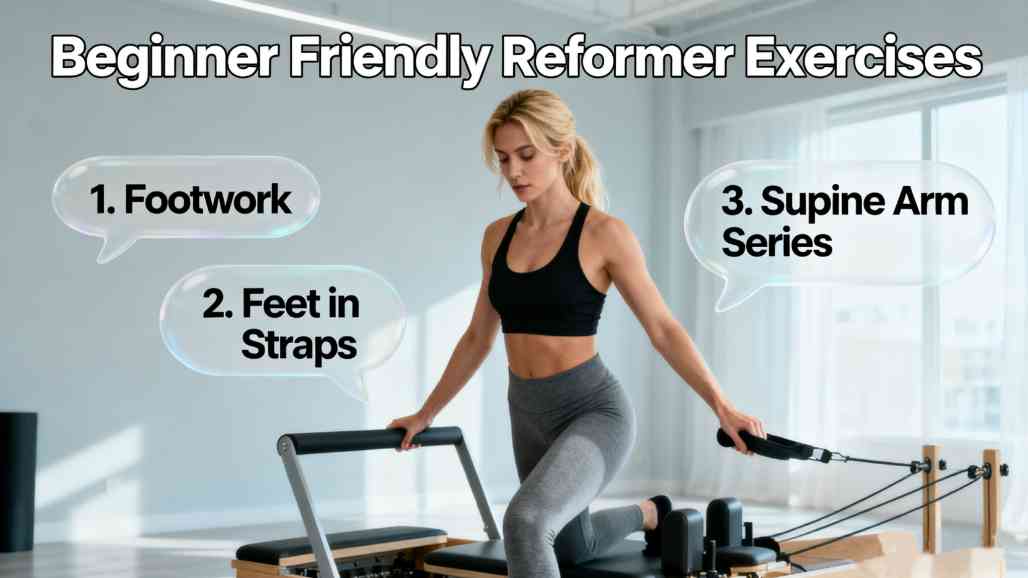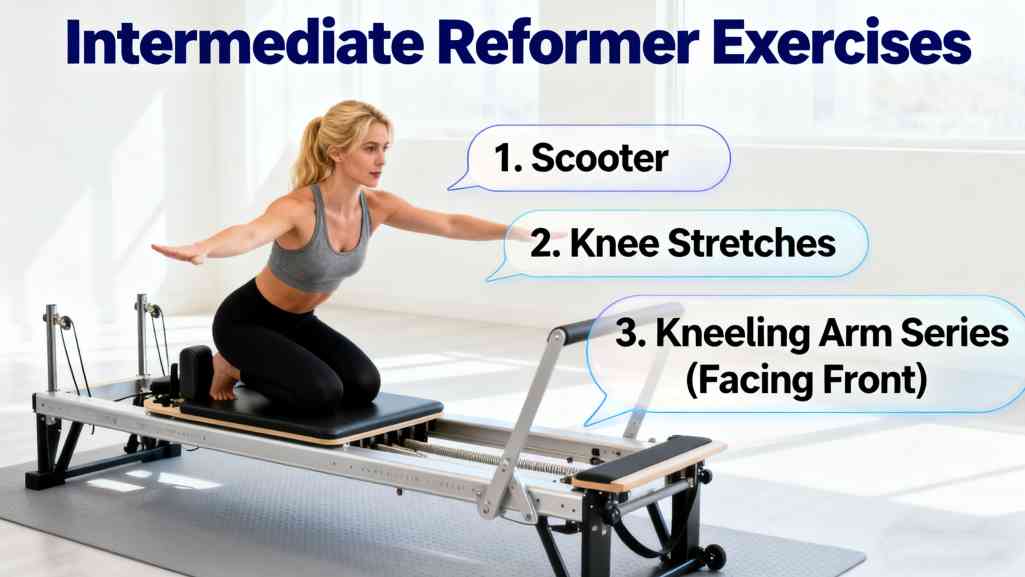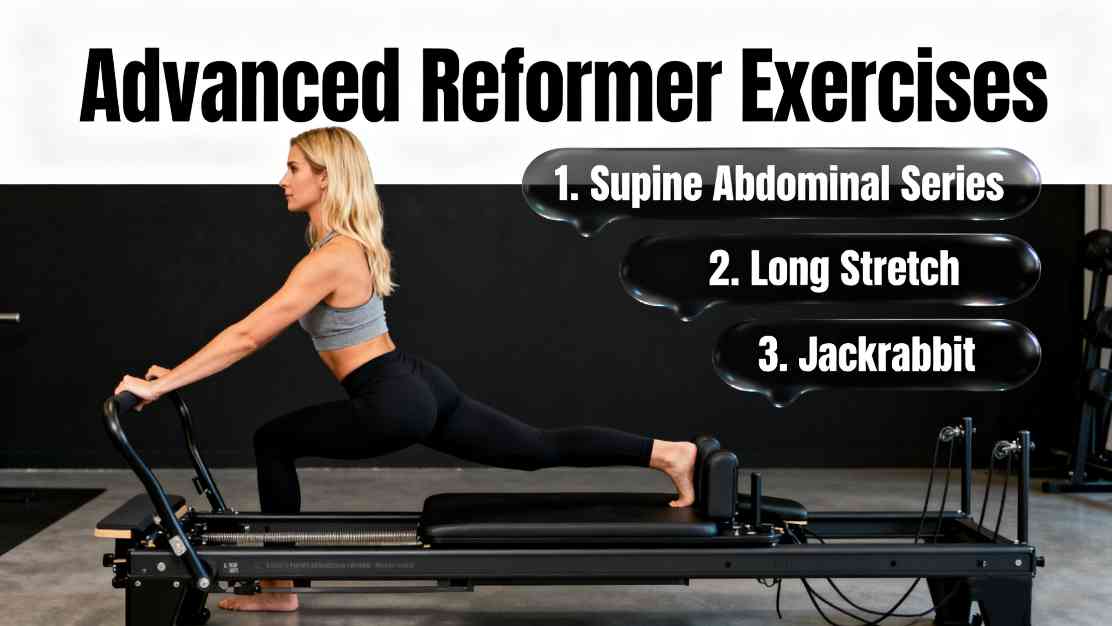The Pilates Reformer is a unique piece of equipment that helps you strengthen your body, improve flexibility, and build better posture. It's suitable for everyone, from beginners to advanced practitioners. With a variety of exercises, you can gradually increase your strength, control, and balance.
✅ Beginner Friendly Reformer Exercises
1. Footwork
How to Do Pilates Reformer:
- Lie on your back with shoulders resting against the shoulder blocks and spine in neutral.
- Place your feet on the footbar in one of the following positions:
* Parallel Heels: heels on the bar, targets hamstrings and glutes.
* Parallel Toes: balls of the feet on the bar, strengthens quads and calves.
* Small V Position: heels together, toes apart, activates inner thighs and quads.
- Inhale to prepare, exhale to press the carriage away, inhale to return with control.
Main Benefits: Strengthens quads, glutes, hamstrings, and calves while improving lower-body alignment using Pilates Reformer resistance.
Common Mistakes:
- Locking the knees or moving too quickly.
- Allowing the pelvis to shift or the lower back to lift.
Tips: Imagine "pressing into the springs" to keep movement smooth and controlled.
2. Feet in Straps
How to Do Pilates Reformer:
- Lie on your back and carefully place both feet into the straps, holding the sides of the carriage for stability.
- Begin from a 90° hip position, then practice common variations:
* Frogs: heels together, knees open, exhale to extend legs out, inhale to bend back.
* Leg Circles: legs extended, circle clockwise and counterclockwise while keeping the pelvis stable.
* Openings: extend legs, open to the sides, then return to center.
- Perform 6–10 reps of each variation.
Main Benefits: Improves hip mobility, strengthens hamstrings and inner thighs, and develops core stability on the Pilates Reformer.
Common Mistakes:
- Arching the lower back or rocking the pelvis.
- Moving too fast and losing control.
Tips: Imagine your legs are "moving through water" — fluid and steady.

3. Supine Arm Series
How to Do Pilates Reformer:
- Lie on your back, feet either on the footbar or in tabletop position, holding one strap in each hand.
- Start with arms extended toward the ceiling. Common variations include:
* Arms Down: exhale as you press arms down toward your hips, inhale to return up.
* Triceps Press: elbows bent at 90°, exhale to extend arms straight.
* Arm Circles: keep shoulders stable while making small controlled circles.
- Perform 6–8 reps of each exercise.
Main Benefits: Strengthens shoulders, chest, and triceps while enhancing core stability with Pilates Reformer strap resistance.
Common Mistakes:
- Shrugging shoulders and creating neck tension.
- Overextending arms and lifting the rib cage.
Tips: Picture "sliding shoulders into your back pockets" to keep your neck relaxed and torso steady.
We are committed to delivering exceptional support and
top-tier service whenever you need it!
✅ Intermediate Reformer Exercises
1. Scooter
How to Do Pilates Reformer:
- Stand on the Pilates Reformer with one foot against the shoulder block and the other foot on the floor beside the carriage.
- Place hands lightly on the footbar for balance.
- Keep the standing leg slightly bent, then press the carriage back by extending the hip of the foot on the platform.
- Exhale to push, inhale to return with control.
Main Benefits: Strengthens glutes, hamstrings, and quads while improving single-leg stability and balance on the Reformer.
Common Mistakes:
- Leaning too heavily onto the footbar.
- Overextending the moving leg instead of controlling the range.
Tips: Keep weight centered over the standing leg and think of "sliding the carriage smoothly" rather than kicking it away.
2. Knee Stretches
How to Do Pilates Reformer:
- Kneel on the carriage with hands on the footbar, shoulders stacked over wrists, and knees against the shoulder blocks.
- Draw the abdominals in, rounding the back into flexion.
- Push the carriage back by extending the knees and hips, then pull it forward while maintaining the rounded shape.
- Variations include Flat Back (neutral spine) and Arched Back (extension).
Main Benefits: Builds core stability, hip mobility, and leg power while challenging endurance on the Pilates Reformer.
Common Mistakes:
- Moving the spine instead of keeping it stable.
- Using momentum instead of muscular control.
Tips: Keep the torso "frozen in space" while the legs drive the motion. Maintain steady breathing to avoid tension.

3. Kneeling Arm Series (Facing Front)
- Kneel on the Reformer carriage facing the pulleys, holding one strap in each hand.
- Maintain a long spine and neutral pelvis throughout.
- From arms extended forward, practice variations such as:
* Chest Expansion: pull arms straight back, then return with control.
* Biceps Curls: bend elbows, bringing hands toward shoulders.
* Hug-a-Tree: arms open wide to the sides, then return forward.
- Perform 6–10 reps of each variation.
Main Benefits: Strengthens shoulders, arms, and upper back, while enhancing postural alignment and core engagement with the Reformer's resistance.
Common Mistakes:
- Arching the lower back or leaning backward.
- Shrugging shoulders up toward the ears.
Tips: Imagine "growing taller through the crown of your head" to stay lifted and stable.
✅ Advanced Reformer Exercises
1. Supine Abdominal Series
How to Do Pilates Reformer:
- Lie on your back on the Pilates Reformer carriage, feet in straps or holding ropes depending on the variation.
- Bring legs to tabletop or extend straight to a 45° angle.
- Perform classical abdominal sequences such as:
* Hundred: pump the arms vigorously while holding legs at 45°.
* Single-Leg Stretch: one leg bends in while the other extends out, switching with control.
* Double-Leg Stretch: both legs extend outward while arms reach overhead, then circle arms back to the knees.
- Keep head, neck, and shoulders lifted the entire time.
Main Benefits: Builds intense core strength, stamina, and coordination, while challenging spinal stability on the Pilates Reformer.
Common Mistakes:
- Allowing the lower back to arch away from the carriage.
- Pulling on the neck with the hands during curls.
Tips: Keep ribs anchored and abdominals scooped in, maintaining a steady breathing rhythm.
2. Long Stretch
How to Do Pilates Reformer:
- Begin in a strong plank position on the Pilates Reformer: hands placed firmly on the footbar, feet on the headrest or shoulder blocks.
- Keep the body in one straight line from head to heels, abdominals drawn in.
- Inhale to press the carriage back, exhale to return forward without collapsing the hips.
Main Benefits: A total-body strengthening exercise that challenges the core, arms, shoulders, and glutes while improving balance and stability on the Pilates Reformer.
Common Mistakes:
- Letting hips sag or lower back arch.
- Allowing shoulders to collapse toward the bar.
Tips: Think of holding a "lifted plank," staying tall through the crown of the head and strong through the heels.

3. Jackrabbit
How to Do Pilates Reformer:
- Kneel on the Pilates Reformer carriage, placing hands firmly on the footbar with arms straight.
- Round the spine into a deep C-curve, tucking the pelvis under.
- Push the carriage back by extending the legs, then pull it forward by scooping the abdominals and deepening the curve.
- Keep the head aligned with the arms throughout the movement.
Main Benefits: Strengthens deep core muscles, enhances spinal articulation, and builds upper-body stability using the Pilates Reformer.
Common Mistakes:
- Driving the movement from the legs rather than the abdominals.
- Collapsing shoulders or tensing the neck.
Tips: Imagine being "scooped up and forward," allowing the abs to initiate the entire motion.
✅ Conclusion
Whether you're just starting or ready for a challenge, the Pilates Reformer offers a safe and effective way to improve your body. Practicing beginner, intermediate, and advanced exercises helps you get stronger, more flexible, and more aware of your movement every day.

Talk To Our Experts
Connect with an NQ expert to discuss your product needs
and get started on your project.
✅ FAQs About Pilates Reformer
Q1: What is a Pilates Reformer and why should I use it?
A: The Pilates Reformer is a piece of equipment with a sliding carriage, springs, and straps that provide resistance. It helps improve strength, flexibility, balance, and posture while offering a low-impact workout suitable for all levels.
Q2: How do I know if I should start with beginner, intermediate, or advanced Reformer exercises?
A: If you are new to Pilates or haven’t exercised regularly, start with beginner exercises to learn proper form and control. Intermediate exercises are for those with a solid foundation, and advanced exercises challenge strength, flexibility, and coordination further.
Q3: Can Pilates Reformer exercises help with core strength?
A: Yes! Every level of Reformer exercise engages the core. Beginner exercises focus on activation and stability, intermediate exercises build strength and endurance, and advanced exercises challenge control and power.
Q4: How often should I practice Pilates Reformer exercises?
A: For best results, 2–4 sessions per week is recommended. Beginners can start with shorter sessions, while intermediate and advanced practitioners can handle longer, more challenging routines.
Q5: Do I need an instructor to do Pilates Reformer exercises safely?
A: While some people can practice at home with guidance, working with a trained instructor is highly recommended, especially for beginners and those attempting advanced exercises, to ensure proper form and prevent injury.
Post time: Sep-15-2025
